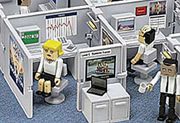
In my previous life working in an office building, I saw first hand the amount of paper and waste thrown out every day. Once used paper, coffee cups, toner cartridges, shipping boxes…you name it, we threw it out. Los Angeles is notorious for not having a comprehensive recycling program, with most apartments not having recycling bins AT ALL. People are told to bring their recyclables to drop off points, which not too many people do. But back to offices, which are kind of the same here in L.A.. The building I used to work in had no recycling program at all…everything went in the trash. It was a huge building, and at the end of every day the bins would be full. I talked to the building manager and tried to implement a recycling program, but they wanted nothing to do with it. I figured with my experience trying to deal with them, I would put together a small list of things you can do to try to “green” your office building.
1. Start small.By talking with the boss of your company, or the person in charge of such things, maybe it would be possible to at least get recycling bins put around the office to collect all the paper scraps and aluminum or glass containers in the kitchen. If your city does not have recycling pick-up, there are companies out there that specialize in setting up programs where they come to your office on a weekly basis to pick up any and all recycling.
2. Try to make it office policy that everyone at least turns off their monitors, if not their computers, before they head out for the day. I know in some offices it is not possible to turn off the computers for network reasons, but there is no reason the monitor has to be on. When I was ready to leave for the day, I used to walk around turning off all the computer monitors. People wondered for years how their monitors were turned off at night and I just kept my mouth shut. Seems having to press the “on” button in the morning was really a bother.
3. A lot of companies provide bottled water to their employees, but often this is in individual bottles that are kept in the refrigerator. Try to talk to the person in charge of buying food and supplies for the office to see if it would be possible to put in a water cooler and some plastic or glass cups that everyone can use. That way, paper cups and plastic water bottles do not have to be put in the trash or recycling bin every day.
4. Make sure that the paper that is used in copiers and printers is 100% post consumer recycled paper.All the big box stores like Staples and Office Max carry this, and there is absolutely no reason that paper should not be of the recycled kind. Offices use fifteen million sheets of office paper every FIVE minutes, so imagine how many trees are being destroyed so you can print out your TPS reports. (If you do not know what a TPS report is, you missed an incredible movie)
5. If possible, change habits in the kitchen.Try to get the company to buy real forks and knives and stop buying plastic ones that are only used once. This can save a landfill from getting filled up with even more plastic then it already is.
6. Sure, it might be a difficult sell, but see if your company would be interested in participating in a mass transit program.Most transit lines in the U.S. offer discounts and other perks to companies that subsidize or pay for their employees to take the bus or subway. Think of the saving not only on your wallet, but also the air we all breathe.
7. Contact the people you lease (yes, most companies lease, they do not own) your copiers and fax machines from to see if they have models that will print on both sides of the paper.Most of them will have them, and presenting the idea to your boss as a money saver and not an environmental move would probably be more influential.
8. If you happen to work in the shipping department, reuse those boxes!Just because it says something on the side of the box does not mean that it is no good. Sure, you might not want to send something to a paying customer in a box with some other company’s name on the side, but there are plenty of times you can reuse boxes no matter what they say on the side!
9. When the need for a meeting comes up that entails travel outside your area, think about if you could accomplish the same goals by teleconferencing.With today’s technology, you can instant message, VOIP, create forums or discussion groups, and even have face to face meetings via web cams. If you don’t NEED to be there in person, save the company some money and the environment some damage by not traveling.
10. If you have windows in your office, be sure to use the free light that is outside!
Turn off those overhead lights and work by natural light; its better for your eyes and the environment.

